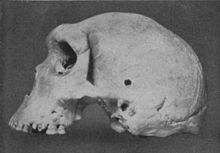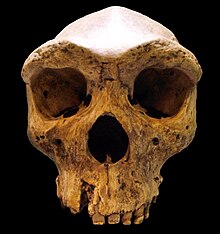| Revision as of 23:22, 12 August 2008 editFunkMonk (talk | contribs)Autopatrolled, Extended confirmed users, Page movers, File movers, Pending changes reviewers102,663 edits Replaced drawing.← Previous edit | Revision as of 01:21, 15 August 2008 edit undoFunkMonk (talk | contribs)Autopatrolled, Extended confirmed users, Page movers, File movers, Pending changes reviewers102,663 editsNo edit summaryNext edit → | ||
| Line 18: | Line 18: | ||
| '''''Homo rhodesiensis''''' is a possible ] species described from the fossil '']''. Other ]-comparable remains have been found from the same, or earlier, time period in southern Africa (Hopefield or ''Saldanha''), East Africa (Bodo, Ndutu, Eyasi, Ileret) and North Africa (Salé, Rabat, Dar-es-Soltane, Djbel Irhoud, Sidi Aberrahaman, Tighenif). These remains were dated to be between 125,000 and 600,000 years old. | '''''Homo rhodesiensis''''' is a possible ] species described from the fossil '']''. Other ]-comparable remains have been found from the same, or earlier, time period in southern Africa (Hopefield or ''Saldanha''), East Africa (Bodo, Ndutu, Eyasi, Ileret) and North Africa (Salé, Rabat, Dar-es-Soltane, Djbel Irhoud, Sidi Aberrahaman, Tighenif). These remains were dated to be between 125,000 and 600,000 years old. | ||
| ] | |||
| ] | |||
| In Africa, there is a distinct difference in the ] tools made before and after 600,000 years ago with the older group being thicker and less symmetric and the younger being more extensively trimmed. This may be connected with the appearance of ''Homo rhodesiensis'' in the archaeological record at this time who may have contributed this more sophisticated approach. | In Africa, there is a distinct difference in the ] tools made before and after 600,000 years ago with the older group being thicker and less symmetric and the younger being more extensively trimmed. This may be connected with the appearance of ''Homo rhodesiensis'' in the archaeological record at this time who may have contributed this more sophisticated approach. | ||
Revision as of 01:21, 15 August 2008
| It has been suggested that this article be merged with Rhodesian Man. (Discuss) Proposed since July 2008. |
| Homo rhodesiensis Temporal range: Pleistocene | |
|---|---|

| |
| Skull found in 1921 | |
| Scientific classification | |
| Kingdom: | Animalia |
| Phylum: | Chordata |
| Class: | Mammalia |
| Order: | Primates |
| Family: | Hominidae |
| Tribe: | Hominini |
| Genus: | Homo |
| Species: | H. rhodesiensis |
| Binomial name | |
| †Homo rhodesiensis Woodward, 1921 | |
Homo rhodesiensis is a possible hominin species described from the fossil Rhodesian Man. Other morphologically-comparable remains have been found from the same, or earlier, time period in southern Africa (Hopefield or Saldanha), East Africa (Bodo, Ndutu, Eyasi, Ileret) and North Africa (Salé, Rabat, Dar-es-Soltane, Djbel Irhoud, Sidi Aberrahaman, Tighenif). These remains were dated to be between 125,000 and 600,000 years old.


In Africa, there is a distinct difference in the Acheulian tools made before and after 600,000 years ago with the older group being thicker and less symmetric and the younger being more extensively trimmed. This may be connected with the appearance of Homo rhodesiensis in the archaeological record at this time who may have contributed this more sophisticated approach.
Rupert Murrill has studied the relations between Archanthropus skull of Petralona (Chalcidice, Greece) and Rhodesian Man. Most current experts believe Rhodesian Man to be within the group of Homo heidelbergensis though other designations such as Homo sapiens arcaicus and Homo sapiens rhodesiensis have also been proposed. According to Tim White, it is probable that Homo rhodesiensis was the ancestor of Homo sapiens idaltu (Herto Man), which would be itself at the origin of Homo sapiens sapiens. No direct linkage of the species can so far be determined.
References
| This article includes a list of references, related reading, or external links, but its sources remain unclear because it lacks inline citations. Please help improve this article by introducing more precise citations. (Learn how and when to remove this message) |
- Woodward, Arthur Smith (1921). "A New Cave Man from Rhodesia, South Africa". Nature. 108: 371–372. doi:10.1038/108371a0.
- Singer Robert R. and J. Wymer (1968). "Archaeological Investigation at the Saldanha Skull Site in South Africa". The South African Archaeological Bulletin. 23 (3): 63–73. doi:10.2307/3888485.
- Murrill, Rupert I. (1975). "A comparison of the Rhodesian and Petralona upper jaws in relation to other Pleistocene hominids". Zeitschrift für Morphologie und Anthropologie. 66: 176–187..
- Murrill, Rupert Ivan (1981). Ed. Charles C. Thomas (ed.). Petralona Man. A Descriptive and Comparative Study, with New Information on Rhodesian Man. Springfield, Illinois. ISBN 0-398-04550-X.
{{cite book}}: CS1 maint: location missing publisher (link) - White; et al. (2003). "Pleistocene Homo sapiens from Middle Awash, Ethiopia". Nature. 423 (6491): 742–7. doi:10.1038/nature01669.
{{cite journal}}: Explicit use of et al. in:|author=(help) - Rightmire, G. Philip (2005). "The Lake Ndutu cranium and early Homo Sapiens in Africa". American Journal of Physical Anthropology. 61 (2): 245–254..
- Asfaw, Berhane (2005). "A new hominid parietal from Bodo, middle Awash Valley, Ethiopia". American Journal of Physical Anthropology. 61 (3): 367–371..
See also
- List of fossil sites (with link directory)
- List of hominina (hominid) fossils (with images)
| Human evolution | |||||||||||||||||||||||||||
|---|---|---|---|---|---|---|---|---|---|---|---|---|---|---|---|---|---|---|---|---|---|---|---|---|---|---|---|
| Taxonomy (Hominins) |
| ||||||||||||||||||||||||||
| Ancestors |
| ||||||||||||||||||||||||||
| Models |
| ||||||||||||||||||||||||||
| Timelines | |||||||||||||||||||||||||||
| Others | |||||||||||||||||||||||||||